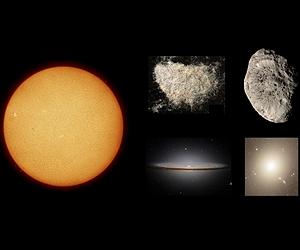 In space, objects tend to conform to one of five shapes: (clockwise from left) spheres, dust, potatoes, halos and disks. Image: Lineweaver, Norman and Chopra |
Canberra, Australia (SPX) Apr 26, 2010
New research from the Australian National University has further reduced the status of Pluto by suggesting there are many more dwarf planets in the Solar System than previously thought.
ANU astronomers have just published results that would reclassify what it is to be a dwarf planet, increasing the number of Pluto's fellow travellers by a factor of ten.
The International Astronomical Union classifies objects in the Solar System into three groups: planets, dwarf planets, and small solar system bodies. In 2006, Pluto was demoted from planet to dwarf planet, leaving eight planets, five dwarf planets and thousands of small solar system bodies orbiting the Sun.
Dr Charley Lineweaver and Dr Marc Norman from the ANU Planetary Science Institute looked at how spherical the icy moons in our solar system are, and recalculated the size of objects at the boundary between dwarf planets and small solar system bodies. Previous estimates have classified icy objects with radii larger than 400 km as dwarf planets.
The new research suggests that this radius should be closer to 200 km, which would increase the number of objects classified as dwarf planets to roughly 50.
The boundary between dwarf planets and small solar system bodies is based on whether the object is round or not.
"Small solar system objects are irregularly shaped, like potatoes," Dr Lineweaver said. "If an object is large enough that its self-gravity has made it round, then it should be classified as a dwarf planet. We calculated how big rocky objects (like asteroids) have to be, and how big icy objects (like the moons of the outer planets and objects further out than Neptune) have to be, for their self-gravity to make them round. For icy objects we found a 'potato radius' of roughly 200km - about half as large as the roughly 400km radius now used to classify dwarf planets.
"The boundary between dwarf planets and small solar system bodies is somewhat arbitrary, but is based on the concept of hydrostatic equilibrium, or how round an object is. Whether the self-gravity of an object is strong enough to make the object round depends on the strength of its material. That is why strong rocky objects need to have a radius of roughly 300km before they turn from lumpy, potato-shaped bodies into spheres, while weaker icy objects can be spheres with a radius of only roughly 200km."
Lineweaver and Norman's paper "The Potato Radius: a Lower Minimum Size for Dwarf Planets" will be published in the Proceedings of the 9th Australian Space Science Conference, eds W. Short and I. Cairns, and is available at www.mso.anu.edu.au/~charley/publications.html
Studying dwarf planets and objects in the Kuiper Belt can help astrobiologists get a better picture of how our solar system formed and how it was able to support habitable worlds like Earth. Some scientists also believe that impactors that have struck Earth in the past, such as comets, could have originated from this mysterious region of the solar system. Studying Kuiper Belt objects can help astrobiologists understand the likelyhood of such objects entering into collision-course orbits with Earth in the future.

Adding more dwarf planets is in no way another demotion for Pluto. The reason is that in spite of the controversial IAU decision, dwarf planets are planets too. Dr. Alan Stern, who coined the term, intended it to refer to a subclass of planets large enough to be in hydrostatic equilibrium (pulled into a round shape by their own gravity) but not large enough to gravitationally dominate their orbits. He never intended dwarf planets to be designated as not planets at all. And he said he anticipates there being hundreds of these small planets in our solar system.
ReplyDeleteOnly four percent of the IAU voted on this, and most are not planetary scientists. Their decision was immediately opposed in a formal petition by hundreds of professional astronomers led by Dr. Alan Stern, Principal Investigator of NASA’s New Horizons mission to Pluto. Stern and like-minded scientists favor a broader planet definition that includes any non-self-luminous spheroidal body in orbit around a star. The spherical part is important because objects become spherical when they attain a state known as hydrostatic equilibrium, meaning they are large enough for their own gravity to pull them into a round shape. This is a characteristic of planets and not of shapeless asteroids and Kuiper Belt Objects. Pluto meets this criterion and is therefore a planet. Under this definition, our solar system has 13 planets: Mercury, Venus, Earth, Mars, Ceres, Jupiter, Saturn, Uranus, Neptune, Pluto, Haumea, Makemake, and Eris.